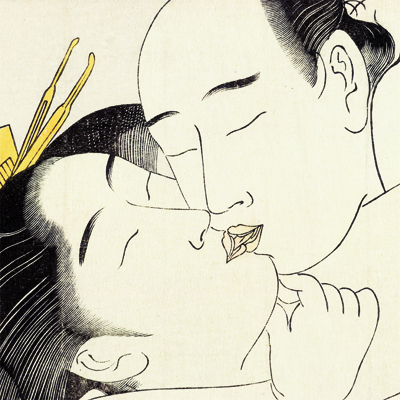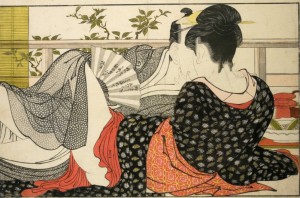
British Museum Rooms 90-91 3 October 2013-5 January 2014
Admission charge. Parental Guidance Advised.
In early modern Japan, 1600-1900, thousands of sexually explicit paintings, prints, and illustrated books with texts were produced, known as ‘spring pictures’ (shunga). Official life in this period was governed by strict Confucian laws, but private life was less controlled in practice.
Often tender, funny and beautiful, shunga were mostly done within the popular school known as ‘pictures of the floating world’ (ukiyo-e), by celebrated artists such as Kitagawa Utamaro (died 1806) and Katsushika Hokusai (1760-1849). This was very different from the situation in contemporary Europe, where religious bans and prevailing morality enforced an absolute division between ‘art’ and ‘pornography’.
Early modern Japan was certainly not a sex-paradise. However, the values promoted in shunga are generally positive towards sexual pleasure for all participants. Women’s sexuality was readily acknowledged and male-male sex recognised in particular social contexts.
Shunga is in some ways a unique phenomenon in pre-modern world culture, in terms of the quantity, the quality and the nature of the art that was produced. This exhibition — which features some 170 works of explicit shunga paintings, sets of prints and illustrated books drawn from collections in the UK, Japan, Europe and USA — explores some key questions about what is shunga, how it circulated and to whom, and why was it produced. In particular it begins to establish the social and cultural contexts for sex art in Japan.
During the late nineteenth and twentieth centuries, shunga was all but removed from popular and scholarly memory in Japan and became taboo. The ambition of the exhibition is to reaffirm the importance of shunga in Japanese and world history.

In conjunction with the exhibition, British Museum Press will publish a lavish scholarly catalogue of some 550 pages and with 400 colour illustrations, edited by Timothy Clark (British Museum), C. Andrew Gerstle (SOAS, University of London), Akiko Yano (SOAS) and Aki Ishigami (Ritsumeikan University, Kyoto), and with contributions from more than thirty authors worldwide.
Timothy Clark talks about the exhibition here in an article from the British Museum Magazine.
The exhibition is part of Japan400, a nationwide UK series of events celebrating 400 years of Japan-British relations.
For more information on the exhibition, please see the British Museum website and the dedicated exhibition page here
The exhibition has been generously sponsored by Shunga 2014 Tokyo LLP and the Leverhulme Trust 
See also ‘the Night of Longing’… a complementary exhibition at the Fitzwilliam Museum, Cambridge.
Shunga and the World, a talk by Professor Timon Screech on 4 October 2013
Shunga: sex and pleasure in Japanese Art, a talk by Tim Clark Professor C. Andrew Gerstle, Dr Aki Ishigami and Dr Akiko Yano at the Daiwa Anglo-Japanese Foundation on 9 October 2013
This post is also available in: 英語
